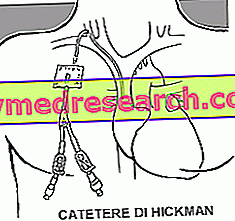Generality
The Holter blood pressure is a diagnostic procedure of the total duration of 24 hours, which, through the use of a portable sphygmomanometer, allows to measure the arterial pressure of an individual every 30 minutes.

Image from the site www.oncallmedicalsupplies.co.uk
The portable sphygmomanometer is very similar to a classic sphygmomanometer for standard pressure measurement. To differentiate it from the latter are the ability to operate autonomously, once power on, and to save the data of each pressure measurement on an internal memory.
Physicians submit those individuals with sudden and marked fluctuations in blood pressure and symptoms related to them to Holter blood pressure.
The Holter pressure is an examination of simple preparation and minimal risks. To avoid distorting the results of the examination, during the 24 hours in which it takes place, the patient must be careful not to bump or move the measuring instrument
What is the Pressure Holter?
The Holter blood pressure is a diagnostic test that allows the measurement of an individual's arterial pressure at regular intervals, over a period of 24 hours.
In other words, the Holter blood pressure consists in a periodic monitoring of the arterial pressure, long throughout a whole day.
The pressure vessel uses an instrument called a portable sphygmomanometer .
THE INSTRUMENT
The portable sphygmomanometer is, in fact, a normal sphygmomanometer of small dimensions, capable of operating independently, after initial power up.
It consists of a comfortable inflatable band, connected, via a rubber cable, to a small blood pressure meter, very similar to a musical walkman .
In addition to measuring blood pressure, the blood pressure meter has an internal memory in which it records the result of each individual measurement.
Readers interested in knowing in detail how blood pressure is measured can consult the article here.
uses
Blood pressure is a vital parameter, which can also vary markedly during a whole day: for example, it undergoes changes during sleep, during a physical activity, following an anxiety attack, with the adoption of a particular diet, after taking certain pressure medications, due to a cardiovascular problem etc.
Who made the portable sphygmomanometer, for the execution of the Holter blood pressure, wanted to make available to doctors a tool capable of grasping and giving meaning to the daily fluctuations of blood pressure, fluctuations that a normal sphygmomanometer is not able to highlight .
It is clear that a healthy person, whose only pressure fluctuations are the physiological ones, has no need to undergo a pressure Holter. On the contrary, the one who shows symptoms or clinical signs in some way related to pathological changes in blood pressure is absolutely necessary.
For pathological changes in blood pressure, sudden and marked changes in blood pressure are meant, upwards or downwards.
AIMS IN BRIEF
Subjects are ideal candidates for a pressure Holter with:
- Symptoms of hypotension during the day.
- Symptoms of hypertension .
- Symptoms preceding episodes of syncope and pre- syncope .
- Heart problems, such as arrhythmias .
- Serious stress or anxiety problems.
Furthermore, through a pressure Holter, doctors are able to evaluate the effects of a drug-based therapy for the normalization of blood pressure .
Preparation
In general, in view of a pressure Holter, doctors provide patients with two simple preparatory indications, which are:
- Wear clothes (in this case sweaters and sweaters) that are comfortable and easy to remove and put back on.
This reduces the risk of bumping or moving the instrument that measures arterial pressure, causing it to malfunction.
- Keep a sort of clinical diary, in which to report if and at what times of the day suspicious disorders have appeared and could be linked to some health problem. The diary is very useful to the doctor during the interpretation phase of the pressure records, once the 24 hours of the Holter blood pressure have passed.
Procedure
The general task of a nurse, the installation of the portable sphygmomanometer is a simple, fast and painless procedure, which involves the application of the inflatable band to the patient's arm and the placement of the measuring instrument in a special hookable pocket around the waist, for middle of a belt. In general, this first phase of the procedure takes about ten minutes, no more.
Once installation is complete, the phase dedicated to calibrating the instrument begins.
The calibration phase involves the comparison between a measurement carried out by means of a standard sphygmomanometer (NB: it is the control or reference measurement) and a measurement carried out by means of the gauge for the pressure holter.
If the results of the two measurements match, it means that the portable sphygmomanometer is well calibrated and works as well as a reliable standard sphygmomanometer.
Generally, between the two measurements, doctors spend between 20 and 30 minutes.
At the end of the calibration phase, the patient can return home and engage in normal daily life activities, avoiding for obvious reasons sporting activities or other movements that could move the elastic band or damage the measuring instrument for the pressure holter.
WHAT DOES THE DURING THE 24 HOURS OF THE EXAM?
After it is turned on and an internal timer is used, the measuring instrument for the pressure monitor performs a blood pressure measurement approximately every 30 minutes .
At the moment when the measurement is made, the inflatable band placed on the patient's arm swells, just like when using a standard sphygmomanometer.
Every measure generally ends within a few seconds; at the conclusion, the band deflates and everything returns to normal.
END OF PROCEDURE
At the end of the 24 hours foreseen by the Holter blood pressure, the patient must go to the doctor or hospital center, which has taken care of installing the instrumentation, to uninstall the portable sphygmomanometer and deliver the clinical diary to the proper authorities.
In general, before uninstalling the sphygmomanometer, the attending physician takes a standard blood pressure measurement, and then compares it with the last change from the Holter blood pressure. This comparison serves to understand if the measuring instrument was still well calibrated even at the end of the exam.
The removal of the instrument for the pressure holter generally takes a few minutes.
WARNINGS OF USE
During the 24 hours of the exam, in addition to avoiding intense physical activity and dangerous movements, the patient should:
- Remain as still as possible, when the portable sphygmomanometer measures blood pressure. This warning is easy to follow, as the inflation of the band is clearly recognizable.
Moving during the measurement alters the detection of blood pressure and the data stored in memory is not reliable.
- Leave the sphygmomanometer in its pocket .
- Don't take showers or toilets . It is good practice to wash before the exam, so that there is no need for it in the following hours.
risks
The Holter pressure is a risk-free diagnostic test.
Results
The results of the pressure monitor are available within a few days.
These are the result of the doctor's observation of the measurements made by the measuring instrument.
Particularly important, on the final judgment, is also the consultation of the clinical diary, carried out by the patient during the pressure holter.



